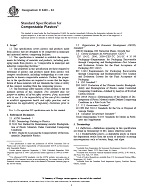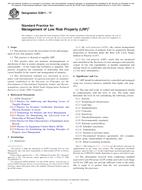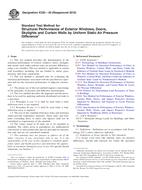1.1 This Guide describes actions that could be taken by the user to minimize human exposures to unbound, engineered nanoscale particles (UNP) in research, manufacturing, laboratory and other occupational settings where UNP may reasonably be expected to be present. It is intended to provide guidance for controlling such exposures as a cautionary measure where neither relevant exposure standards nor definitive hazard and exposure information exist.
1.2 General Guidance – This Guide is applicable to occupational settings where UNP may reasonably be expected to be present. Operations across those settings will vary widely in the particular aspects relevant to nanoscale particle exposure control. UNP represent a vast variety of physical and chemical characteristics (e.g., morphology, mass, dimension, chemical composition, settling velocities, surface area, surface chemistry) and circumstances of use. Given the range of physical and chemical characteristics presented by the various UNP, the diversity of occupational settings and the uneven empirical knowledge of and experience with handling UNP materials, the purpose of this Guide is to offer general guidance on exposure minimization approaches for UNP based upon a consensus of viewpoints, but not to establish a standard practice nor to recommend a definite course of action to follow in all cases.
1.2.1 Accordingly, not all aspects of this Guide may be relevant or applicable to all circumstances of UNP handling. The user should apply reasonable judgment in applying this Guide including consideration of the characteristics of the particular UNP involved, the users engineering and other experience with the material, and the particular occupational settings where the user may apply this Guide. Users are encouraged to obtain the services of qualified professionals in applying this Guide.
1.2.2 Applicable Where Relevant Exposure Standards Do Not Exist – This Guide assumes that the user is aware of and in compliance with any authoritative occupational exposure standard applicable to the bulk form of the UNP. This Guide may be appropriate where such exposure standards do not exist, or where such standards exist, but were not developed with consideration of the nanoscale form of the material.
1.3 Applicable Where Robust Risk Information Does Not Exist – This Guide assumes the absence of scientifically sound risk assessment information relevant to the particular UNP involved. Where sound risk assessment information exists, or comes to exist, any exposure control measures should be designed based on that information, and not premised on this Guide. Such measures may be more or less stringent than those suggested by this Guide.
1.4 Materials within Scope – This Guide pertains to unbound engineered nanoscale particles or their respirable agglomerates or aggregates thereof. Relevant nanoscale particle types include, for example, intentionally produced fullerenes, nanotubes, nanowires, nanoropes, nanoribbons, quantum dots, nanoscale metal oxides, and other engineered nanoscale particles. Respirable particles are those having an aerodynamic equivalent diameter (AED) less than or equal to 10 m (10 000 nm) or those particles small enough to be collected with a respirable sampler
1.5 Materials Beyond Scope
1.5.1 UNP may be present in various forms, such as powders or suspensions, or as agglomerates and aggregates of primary particles, or as particles dispersed in a matrix. This Guide does not pertain to UNP incapable, as a practical matter, from becoming airborne or be expected to generate or release UNP in occupational settings under the particular circumstances of use (e.g., UNPs dispersed or otherwise fixed within a solid, strongly bonded to a substrate or contained within a liquid matrix such as aggregated primary crystals of pigments in paints). This guide does not pertain to aggregates or agglomerates of UNP that are not of a respirable size.
1.5.2 This Guide does not pertain to materials that present nanoscale surface features, but do not contain UNPs (e.g., nanoscale lithography products, nanoelectronic structures or materials comprised of nanoscale layers).
1.5.3 This Guide does not pertain to UNPs which exist in nature which may be present in normal ambient atmospheres or are unintentionally produced by human activities, such as by combustion processes. Nor does it pertain to materials that have established exposure control programs (e.g. safe handling protocols for nanoscale biological agents) or published exposure limits such as occupational exposure limits for welding fumes.. See Appendix X1.
1.6 Handling Considerations Beyond ScopeThe use of this Guide is limited to the scope set forth in this section. This Guide generally does not address actions related to potential environmental exposures, nor to exposures potentially arising at disposal or other end-uses.
1.7 Not a Standard of CareThis ASTM standard Guide does not necessarily represent the standard of care by which the adequacy of a set of exposure control measures should be judged; nor should this document be used without consideration of the particular materials and occupational circumstances to which it may be applied. The word “standard” in the title means only that the document has been approved through the ASTM consensus process.
This standard does not purport to address all of the safety concerns, if any, associated with its use. It is the responsibility of the user of this standard to establish appropriate safety and health practices and determine the applicability of regulatory limitations prior to use.
Product Details
- Published:
- 09/15/2007
- Number of Pages:
- 24
- File Size:
- 1 file , 250 KB


